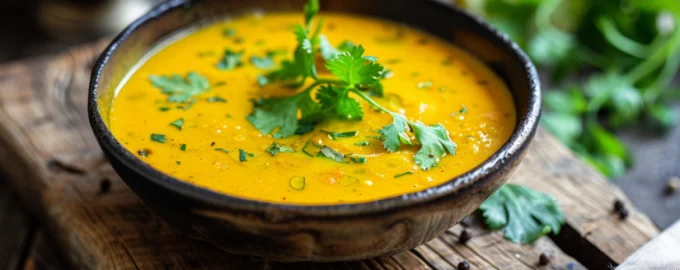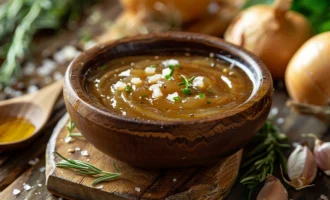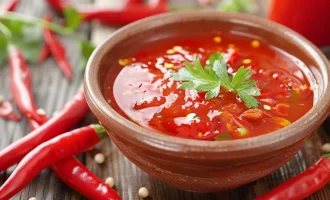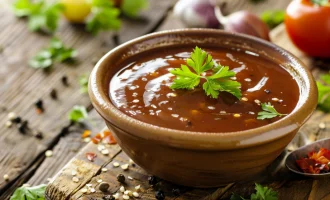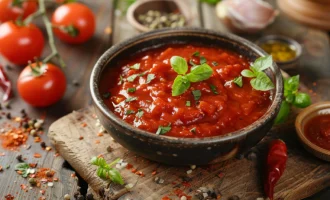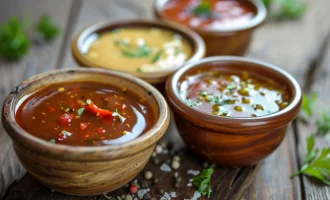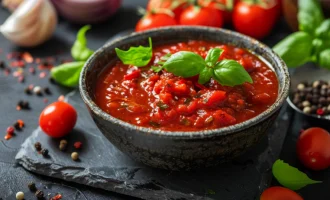Curry sauce, a cornerstone of Indian cuisine, has traversed global boundaries to become a beloved addition to various dishes around the world. Its roots can be traced back thousands of years to the Indian subcontinent, where a myriad of spices were blended to create what is now known as curry. The term “curry” itself is derived from the Tamil word ‘kari’, meaning ‘sauce’ or ‘relish for rice’. Over time, the British popularized the term and the sauce, adapting it to suit Western palates. Today, curry sauce is celebrated for its depth of flavor and versatility, commonly served with meat, vegetables, and rice. It’s a rich, aromatic blend of spices that include turmeric, cumin, coriander, and often a hit of chili for heat.
- Onion 100 g
- Garlic 2 cloves
- Ginger 20 g
- Tomato puree 150 g
- Coconut milk 400 ml
- Vegetable oil 30 ml
- Ground turmeric 5 g
- Ground cumin 5 g
- Ground coriander 5 g
- Chili powder 2 g
- Garam masala 5 g
- Salt 5 g
- Water 100 ml
- Fresh cilantro 10 g
- In a large pan, heat the vegetable oil over medium heat. Add the chopped onions and sauté until they become soft and golden.
- To the onions, add the minced garlic and grated ginger. Stir frequently and cook for another 2 minutes until the aroma is released.
- Lower the heat and add the ground turmeric, cumin, coriander, chili powder, and garam masala. Stir the spices with the onion mixture for about a minute. This process, known as “blooming,” intensifies the flavors of the spices.
- Stir in the tomato puree and cook for 5 minutes, allowing the mixture to thicken slightly and darken in color.
- Pour in the coconut milk and water, then stir well to combine all the ingredients. Simmer on low heat for 20-25 minutes, stirring occasionally. The sauce should reduce and thicken.
- Taste the curry sauce and adjust the seasoning with salt or more chili powder, according to your preference.
- Once ready, sprinkle fresh cilantro over the sauce for a burst of color and freshness.
Storage Tips
Curry sauce can be stored in an airtight container in the refrigerator for up to 5 days or frozen for up to 3 months. Thaw in the refrigerator overnight and reheat gently, adding a little water if the sauce has thickened too much.
Useful Properties of the Main Ingredient
Turmeric, a key ingredient in curry sauce, is renowned for its anti-inflammatory and antioxidant properties, largely attributed to its curcumin content. It’s been linked to a range of health benefits, including improved brain function and lower risk of heart disease.
Interesting Facts
- Cultural Fusion: The concept of curry has been adapted by many cultures, leading to a diverse range of curry sauces around the world, each with its unique flavor profile.
- British Adaptation: The British love for curry led to the creation of dishes like chicken tikka masala, which has become synonymous with British cuisine.
- Spice Trade: The spice trade played a crucial role in the spread of curry flavors, with spices being one of the most sought-after commodities in history.
Curry sauce is more than just a condiment; it’s a global phenomenon that exemplifies the rich tapestry of flavors that can be achieved through the combination of simple ingredients. Its versatility makes it a perfect companion for meat, showcasing how traditional recipes can be adapted to suit a variety of culinary preferences.

